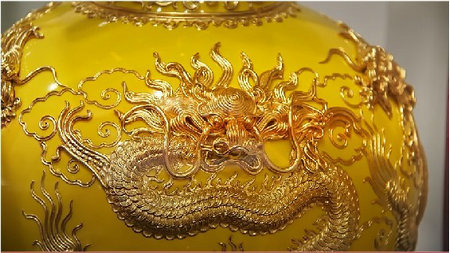Lacquer Engraving
Updated: 2012-08-14 16:03
(www.chinaculture.org)
|
|||||||||||

A traditional lacquer engraving technology, lacquer engraving was a technique widely applied on the lacquer ware of the Ming and Qing Dynasties. The method is to coat the roughcast with dozens or even hundreds of layers of lacquer and then engrave on the lacquer ware landscapes, human figures, flowers, birds and animals. The roughcasts are mainly of wood, coated with lacquers of red, yellow, green, brown and other colors.
Engraving on red lacquer is called "red carving", engraving patterns on alternate red and black coats is called "rhinoceros carving", and engraving on colorful coats is called "color carving". In addition, there are also "yellow carving", "green carving", "black carving" and so on. The most common lacquer ware belongs to "red carving".

The techniques of lacquer engraving began in the Tang Dynasty and prevailed in the Ming and Qing Dynasties. The greatest achievement in the Yuan Dynasty lacquer ware was lacquer engraving, which was characterized by thick layers of lacquer, plump and mellow flower patterns. The overall impression of these works is simplicity and harmonious integrity, yet the details are extremely delicate and meticulous, emitting a special intriguing sense of reality. The works of lacquer engraving in the Ming Dynasty are featuring sublime and natural modeling, and dexterous and vigorous engraving. The lacquer engraving in the Qing Dynasty exhibits features of preciseness and minute details, and extremely delicate rendering. As a result, the Qing lacquer engraving works emit a sense of supreme elegance.
Works of lacquer engraving are characterized by thin roughcast, flamboyant pattern, and firmness and durability.
Related Stories
Cervantes art 2012-08-13 16:55
Master of inkstone carvings in China's Anhui 2012-08-10 15:48
Major exhibition of Chinese contemporary art opens in Budapest 2012-08-10 10:25
The art of optical illusion 2012-08-03 13:42
Jade carvings on show 2012-08-03 10:23
Today's Top News
Rescuers race against time for quake victims
Telecom workers restore links
Coal mine blast kills 18 in Jilin
Intl scholarship puts China on the map
More bird flu patients discharged
Gold loses sheen, but still a safe bet
US 'turns blind eye to human rights'
Telecom workers restore links
Hot Topics
Lunar probe , China growth forecasts, Emission rules get tougher, China seen through 'colored lens', International board,
Editor's Picks

|

|

|

|

|

|





